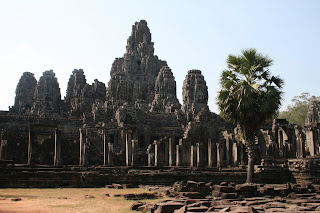This is it. Rising out of the steaming jungle as you tuk-tuk your way past fruit purveyors, tourist buses and other tuk-tuk’s, the five towers of Angkor Wat jut out beyond the safeguarding temple walls, just beyond the massive moat. This is it, you think to yourself, one of those rare Indiana Jones moments, where you get to scramble over timeworn, venerable blocks of Khmer architecture in the overgrown Ta Prohm temple, or push the left eye of a Naga statue or Bayon head to reveal a secret passageway which leads you the discovery of the Hall of Bodhisattvas…oh behold the wonders of Angkor!
A World Heritage Site nearly a millennium old, regal Angkor Wat has stood the test of time to watch nations rise only to fall again and has stood proudly as religions have come and gone. Weather-stained massifs watch over the jungle of Siem Riep as sentinels and guardians, while intricately designed passageways and walls pay homage to Hindu and Buddhist mythology.




The austerity and monumental scale of the Angkor Temple Complex are palpable as hours, even days, are whittled away, inspecting every nook and cranny.






But, alas, you are not alone. No, it’s not the shade of Vishnu or Kali still haunting Angkor Thom or the spectres of long-forgotten Buddhist monks haunting the fields and buildings of Angkor. It’s something else, it’s…other people like you: tourists.

And this is the downside. I was first astounded by Jon’s exposé on the nature of the Angkor Temple Complex and now I’ve seen it for myself. This is the Angkor they don’t want you to see. Thousands of tourists descend on the Temples daily. This is the jostling, elbowing, kicking, biting Angkor. The souvenir-touting, Canon-clicking, elephant-riding, get out of my picture Angkor. You won’t find a picture of this one at any of the gazillion postcard sellers around the temple complex. This is commercialism at its sweaty, dizzied height. The, reduced, scarred essence of greed.


Peruse a detailed, weathered bas-relief, follow the design around a corner and *kadonk* bump into the lens of another Pentax-touting fellow. At times you just wish everyone else would disappear and leave you alone to explore in peace.


Erosion has caused large sections of the temple complex to be closed temporarily for reconstruction and in some places, sadly, permanently. Monks wander around with mobile phones and digital cameras (so much for discarding all your worldly possessions).




It’s a circus; nearly as much so as the town of Siem Riep. The “Angkor” brand has been cashed in on – there is even an Angkor Mart – with a very nice selection of imported chocolates and a range of French and New World wines to warm the heart of any wine enthusiast. Angkor this, Angkor that, it was a kind of overkill, yet inevitably so I guess, looking at the laws of economics: supply and demand. I can just see Smith’s invisible hand reaching for a cold Angkor quart, or changing the setting on his Cybershot.


Despite Angkor’s “I’m lovin’ it” commercialism, it remains – hidden beneath the mountain of souvenir t-shirts, row upon row of fake antiques and beneath the froth of Siem Riep’s cappuccinos and latte’s – one of the world’s most important historic areas for a number of reasons and hopefully this significance will not only be a footnote at the bottom of an Angkor advertisement.



No comments:
Post a Comment